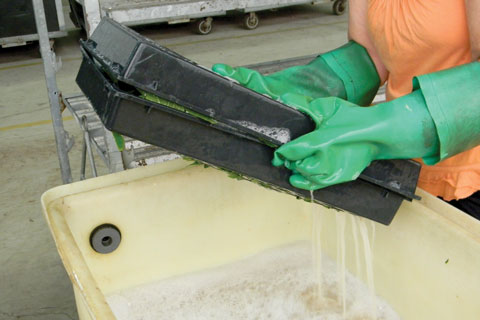9/1/2019
Improve Your Success with Unrooted Cuttings
Julie Martens Forney

When you’re dealing with household issues, problem-solving strategies are pretty easy to figure out. If you have a busted pipe, you call a plumber. If the air conditioner isn’t cooling like it used to, you call your favorite HVAC specialist. But when it comes to finding the best recipe for reviving the latest shipment of poinsettia cuttings, who are you gonna call?
That’s where the American Floral Endowment (AFE) comes in. They stand on the front lines with growers, funding industry-based research that uncovers creative solutions to tough problems—the kind of issues you face on a daily basis.
Making cuttings stronger
When vegetative cutting production moved offshore in the late 1990s, it offered tons of promise. Low-cost labor and energy-efficient growing conditions set the stage for success. Growers gobbled up the product, driving the cutting market to explode. It was the growing industry’s own gold rush of sorts.
“Those early days of shipping more cuttings through the mail internationally uncovered lots of hiccups in the supply chain,” said Dr. Jim Faust, Clemson University. Jim worked with Dr. John Dole, North Carolina State University, to brainstorm and execute projects to help develop protocols for growing stock plants and handling cuttings, from harvest to ship to stick. This included toning the cuttings so they were stronger and more resilient.
 Pictured: With proper dip technique, every cutting should be thoroughly wet on both top and bottom leaf surfaces
Pictured: With proper dip technique, every cutting should be thoroughly wet on both top and bottom leaf surfaces
In theory, a stronger unrooted cutting could navigate shipping stress with ease and come out of the box with a greater capacity to bounce back. The research focused on the offshore growing environment, developing stock plants that would yield the heathiest, strongest cuttings. The research team grew poinsettia and geranium stock plants with different levels of everything from calcium to aspirin and then measured the literal strength of leaf samples.
“We found we were getting 10% to 15% stronger leaves with nutritional treatments,” Jim said. “That meant stock plant growers could spray weekly and produce a cutting that was more toned.”
But calcium sprays don’t just make a cutting more resistant to shipping stresses; they also give it some Botrytis resistance.
“Calcium strengthens the walls of cells inside leaves and flowers; that extra strength makes those cells resistant to Botrytis infection,” Jim explained. “Calcium chloride sprays offer a non-fungicide treatment that Botrytis can’t develop resistance to. If we spray stock plants with calcium, we reduce fungicide use, which can help reduce fungicide resistance in Botrytis. The beauty of using calcium chloride is cost. This is rock salt that’s put on highways. It’s less than $2 an acre to spray it, compared to a fungicide that might cost over $100 per acre.”
For poinsettias and geraniums, recommendations for weekly calcium sprays to produce a stronger, more toned cutting are 400 or 800 ppm, using calcium chloride.
Helping cuttings recover
In the unrooted cutting supply chain, transport presents a big unknown. Shipping delays can result in wilted cuttings with low carbohydrate reserves. Cuttings in that condition might be slow to develop or are disease-prone, if they root at all.
Knowing the unpredictable nature of transport, growers posed the question: Would it be possible to place unrooted cuttings into some kind of recovery solution that would help them bounce back after shipping? John and his research team tackled this part of the cutting puzzle, working with geranium, poinsettias and New Guinea impatiens cuttings. They tested many solutions, including plain water, spray adjuvants, fungicides, sugars and hormones.
The studies ran for three years, and results were consistent:
• Increased stress on unrooted cuttings reduced rooting with all three plants—geranium, poinsettia and New Guinea impatiens.
• Post-harvest cutting dips in recovery solutions clearly improved rooting with all three plant types.
• The best recovery solution recipe for geraniums and poinsettias: 30-minute dip into 400 ppm K-IBA (water-soluble IBA) plus either fructose or Pageant fungicide.
• The best recovery solution recipe for New Guinea impatiens: zero to 30-minute dip into K-IBA solution (400 ppm).
• Not only do recovery solutions help rooting, turgid cuttings are easier to stick.
• Interestingly, unstressed cuttings also benefitted from being dipped in a water + adjuvant solution.
All recovery solutions included Capsil, a spray adjuvant that’s a 100% active blend of organo-silicone and non-ionic surfactants. Adding the wetting agent lets water bridge the waxy cuticle on leaf surfaces.
On crops where the recommendation for a recovery dip varies over a time range, “pull the cuttings out every few minutes to check turgidity,” Jim said. “Don’t submerge cuttings too long because you could end up with water-soaked patches on leaves where the tissue has died and cells have exploded.”
Keeping cuttings pest-free
In a perfect world, cuttings arrive clean, but the reality is that unrooted cuttings are rarely 100% pest-free. Propagators spray stock plants regularly, doing their absolute best to ship clean cuttings. But pests—especially in the early stages of development (when they’re hardest to detect)—often hitch a ride. The team at Vineland Research & Innovation Centre in Ontario assessed the risk of pests in cuttings.
“On chrysanthemums, irrespective of supplier, time of year and variety, cuttings always (90%) had thrips and 50% had spider mites, too,” Dr. Michael Brownbridge said. “Those are two of the most pesticide-resistant pests in the world.”
Canadian growers endured a perfect storm of whiteflies in 2012, which brought the issue of pest control on unrooted cuttings into sharp focus. The problem is that frequent pesticide sprays on stock plants not only help produce pesticide-resistant pests, but also leave pesticide residues that interfere with biocontrol agents. AFE provided funding to expand the dipping studies to include other pests and crops.
“We experimented with dipping unrooted cuttings into insecticidal oils, soaps or biopesticides to kill pests,” Dr. Rose Buitenhuis said. “Our techniques take care of 70% to 90% of whiteflies and thrips that come in on cuttings. This basically turns the clock back in terms of pest development, which gives biocontrol agents time to work.”
The team at Vineland ran studies for three years, looking at different dips and a variety of crops, including pot mums, mini roses and spring bedding plants, such as sweet potato vine, petunia and osteospermum. Dip materials are based on soap, oil and fungi—materials with little or no residual activity and that won’t contribute to pesticide resistance in pests.
Specific dip product recommendations include:
• For Bemisia on poinsettia cuttings: Kopa 0.5% + BotaniGard 22WP 1.25g/L.
• For thrips on chrysanthemum cuttings: BotaniGard 22WP at 2.5g/L.
In both the U.S. and Canada, dipping is on the label for BotaniGard 22 WP. Labels are slowly being expanded to include dipping rates for other products that were found to be effective, like insecticidal soap and mineral oil.
Rose said that growers ask all the time if a certain product will work as a dip.
“With the research that we’ve done, we’ve laid the basis for cutting dips to the point that growers can continue with this as long as they follow the guidelines above. They can do their own research with different materials,” she said. “Just remember that research is research, which means search again and search again. That’s the way to get results.” GT
Researchers whose work contributed to this article include: Dr. Jim Faust and Uttara Samarakoon (Clemson University); Dr. John Dole, Ingram F. McCall and Ben Bergmann (North Carolina State University); Dr. Rose Buitenhuis and Dr. Michael Brownbridge (Vineland Research & Innovation Centre, Ontario); and Dr. Dave Smitley (Michigan State University).
Julie Martens Forney is a freelance writer with more than 25 years of experience writing about floriculture industry issues and gardening for consumers. To read her current bylines, check out SAF’s Floral Management, HGTV.com and DIYNetwork.com. Julie’s also an avid gardener, tending edibles and perennials in a wildlife-friendly garden that features year-round color.